CYK4 inhibits Rac1-dependent PAK1 and ARHGEF7 effector pathways during cytokinesis
- PMID: 22945935
- PMCID: PMC3432774
- DOI: 10.1083/jcb.201204107
CYK4 inhibits Rac1-dependent PAK1 and ARHGEF7 effector pathways during cytokinesis
Abstract
In mitosis, animal cells lose their adhesion to the surrounding surfaces and become rounded. During mitotic exit, they reestablish these adhesions and at the same time physically contract and divide. How these competing processes are spatially segregated at the cell cortex remains mysterious. To address this question, we define the specific effector pathways used by RhoA and Rac1 in mitotic cells. We demonstrate that the MKlp1-CYK4 centralspindlin complex is a guanosine triphosphatase-activating protein (GAP) for Rac1 and not RhoA and that CYK4 negatively regulated Rac1 activity at the cell equator in anaphase. Cells expressing a CYK4 GAP mutant had defects in cytokinesis and showed elevated staining for the cell adhesion marker vinculin. These defects could be rescued by depletion of ARHGEF7 and p21-activated kinase, Rac1-specific effector proteins required for cell adhesion. Based on these findings, we propose that CYK4 GAP activity is required during anaphase to inhibit Rac1-dependent effector pathways associated with control of cell spreading and adhesion.
Figures
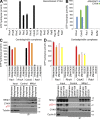
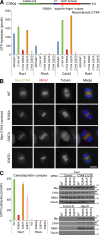
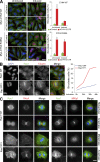



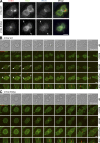
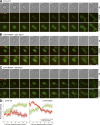

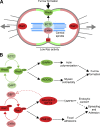
Comment in
-
Stuck in the middle: Rac, adhesion, and cytokinesis.J Cell Biol. 2012 Sep 3;198(5):769-71. doi: 10.1083/jcb.201207197. J Cell Biol. 2012. PMID: 22945931 Free PMC article.
Similar articles
-
Stuck in the middle: Rac, adhesion, and cytokinesis.J Cell Biol. 2012 Sep 3;198(5):769-71. doi: 10.1083/jcb.201207197. J Cell Biol. 2012. PMID: 22945931 Free PMC article.
-
Role of phospholipase Cgamma1 in cell spreading requires association with a beta-Pix/GIT1-containing complex, leading to activation of Cdc42 and Rac1.Mol Cell Biol. 2007 Aug;27(16):5790-805. doi: 10.1128/MCB.00778-07. Epub 2007 Jun 11. Mol Cell Biol. 2007. PMID: 17562871 Free PMC article.
-
A Non-canonical BRCT-Phosphopeptide Recognition Mechanism Underlies RhoA Activation in Cytokinesis.Curr Biol. 2020 Aug 17;30(16):3101-3115.e11. doi: 10.1016/j.cub.2020.05.090. Epub 2020 Jul 2. Curr Biol. 2020. PMID: 32619481 Free PMC article.
-
The guanine nucleotide exchange factor Tiam1: a Janus-faced molecule in cellular signaling.Cell Signal. 2014 Mar;26(3):483-91. doi: 10.1016/j.cellsig.2013.11.034. Epub 2013 Dec 2. Cell Signal. 2014. PMID: 24308970 Review.
-
FilGAP and its close relatives: a mediator of Rho-Rac antagonism that regulates cell morphology and migration.Biochem J. 2013 Jul 1;453(1):17-25. doi: 10.1042/BJ20130290. Biochem J. 2013. PMID: 23763313 Review.
Cited by
-
MgcRacGAP restricts active RhoA at the cytokinetic furrow and both RhoA and Rac1 at cell-cell junctions in epithelial cells.Mol Biol Cell. 2015 Jul 1;26(13):2439-55. doi: 10.1091/mbc.E14-11-1553. Epub 2015 May 6. Mol Biol Cell. 2015. PMID: 25947135 Free PMC article.
-
Stuck in the middle: Rac, adhesion, and cytokinesis.J Cell Biol. 2012 Sep 3;198(5):769-71. doi: 10.1083/jcb.201207197. J Cell Biol. 2012. PMID: 22945931 Free PMC article.
-
Recent advances in cytokinesis: understanding the molecular underpinnings.F1000Res. 2018 Nov 26;7:F1000 Faculty Rev-1849. doi: 10.12688/f1000research.16502.1. eCollection 2018. F1000Res. 2018. PMID: 30542616 Free PMC article. Review.
-
srGAP2 deactivates RhoA to control the duration of thrombin-mediated endothelial permeability.Vasc Biol. 2022 Feb 28;4(1):K1-K10. doi: 10.1530/VB-21-0012. eCollection 2022 Feb 1. Vasc Biol. 2022. PMID: 35441126 Free PMC article.
-
IQGAP1 is a key node within the small GTPase network.Small GTPases. 2013 Oct-Dec;4(4):199-207. doi: 10.4161/sgtp.27451. Epub 2013 Dec 19. Small GTPases. 2013. PMID: 24355937 Free PMC article.
References
-
- Castrillon D.H., Wasserman S.A. 1994. Diaphanous is required for cytokinesis in Drosophila and shares domains of similarity with the products of the limb deformity gene. Development. 120:3367–3377 - PubMed
Publication types
MeSH terms
Substances
Grants and funding
LinkOut - more resources
Full Text Sources
Other Literature Sources
Molecular Biology Databases
Research Materials
Miscellaneous

